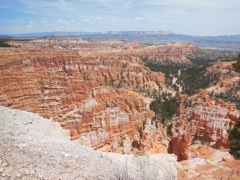![]() Observation: The First Step in the Scientific Method
Observation: The First Step in the Scientific Method
To observe means to examine something and to notice the details. When people observe things, they often wonder why it is that way or wonder what occurred. Scientists strive to answer that question. They make observations. This is the first step of the scientific method.
Observations are also called data. There are two kinds of data.
- Qualitative data which are descriptions that do not have numbers.
Don was amazed by what he observed on his first trip to an ocean beach. There was a odor in the air he had never experienced. He noticed the ocean water was several different colors. The sand was cool beneath his bare feet. Debris littered the sand. These are examples of qualitative data.
- Quantitative data are obtained by measuring and have numbers. Scientists use instruments (tools) to obtain numbers based data.
In conducting a bio survey at the local beach, the girls found that there were: 2 sand dunes. One dune was 30 meters long and 3 meters tall. Several species of grass grew in the dune. They found 52 sea shells lying on the sand. A sorting into similar shapes revealed there were ten different kinds of sea shells. The smallest was 1 centimeter long and shaped like a cylinder. The largest was 10.2 centimeters long and irregularly shaped. There was a dead crab on the beach, too. The shell was dark brown. It had 5 pairs of legs. It also had a 7 centimeter long, narrow tail, with a sharp point at the tip. Elevation - Sea level. Map coordinates Latitude: 39.922086°, Longitude: -74.075244°. These are examples of observations with quantitative data.
Practice observing by examining at this photo from Bryce Canyon, Utah, USA.
Click here for a closer view. Use the Back Button of your browser to return to this web page.
1. Write your observations - one per line - on a piece of paper.
Make as many visual observations as you can.
2. Imagine - If you were standing at the canyon's edge:
What tools (instruments) might you use to gather quantitative data about what you are observing?
3. Form a question about what you have observed.
4. Prediction - Would you expect to find similar data in a different canyon?
Extend your knowledge:
About Units of Measurement - IB Biology | Temperature facts and figures - IB Biology
Bryce Canyon Geology | Bryce Canyon Photo Tour - USGS | Parks of the Colorado Plateau
Rocks and Minerals Internet Hunt - introduction | Water & Watershed Study Unit
Observation Skills Builders | What is a hypothesis? | Chem4Kids | Geology Mapping
Steps of the Scientific Method - Science Buddies | Learn about the Scientific Method Activity
Milkweed and Monarch Butterfly Mania Journal Entry | Learn about the Scientific Method | Bluebirds Project
Fields, Meadows & Fencerows EcoStudy | Wetlands EcoStudy Unit | Habitat Project Digital Science Journal |
Energy & Alternative Energy Studies | Plants & People | Fun with Stratigraphy worksheet
Biodiversity Exploration Investigation | Ecology Community Status in your State's Ecosystem | Lentic and Lotic Ecosystems
Environmental Inquiry | PA Standards Aligned Systems | Science NetLinks
Science Links and Resources | Exploring the Environment modules and activities
![]()
All trademarks, copyright and logos belong to their respective owners.
Internet Hunts / Nature / Water / Computers / Famous Pennsylvanians / Civics & History / Puzzles & Projects / Site map / Home
Posted by Cynthia J. O'Hora 10/2013, released for noncommercial use by nonprofit organizations Updated 3/2015
Aligned with Pennsylvania Academic Standards | Assessment and Rubrics
Pennsylvania Academic Standards - The Nature of Science
Processes, Procedures and Tools of Scientific Investigations
• Apply knowledge of scientific investigation or technological design in different contexts to make inferences to solve problems.
• Use evidence, observations, or a variety of scales (e.g., time, mass, distance, volume, temperature) to describe relationships.
![]() Save a tree use a digital answer format - Highlight the text. Copy it. Paste it in a word processing document. Save the document in your folder. Answer on the wp document in an easily read, contrasting color or font. (Not yellow ) nor fancy fonts like: Symbols, Techno,
Save a tree use a digital answer format - Highlight the text. Copy it. Paste it in a word processing document. Save the document in your folder. Answer on the wp document in an easily read, contrasting color or font. (Not yellow ) nor fancy fonts like: Symbols, Techno, ![]() fancy fonts). Save frequently as you work. I have never liked losing my work. You will not like it either. Be sure to enter your name & the date at the top of the document in a header. Submit via email attachment or an electronic class dropbox. Bad things happen: Save a copy of the response document for your records.
fancy fonts). Save frequently as you work. I have never liked losing my work. You will not like it either. Be sure to enter your name & the date at the top of the document in a header. Submit via email attachment or an electronic class dropbox. Bad things happen: Save a copy of the response document for your records.
Proof your responses. It is funny how speling errors and typeos sneak in to the bets work. ![]() Make your own printer paper answer sheet
Make your own printer paper answer sheet
